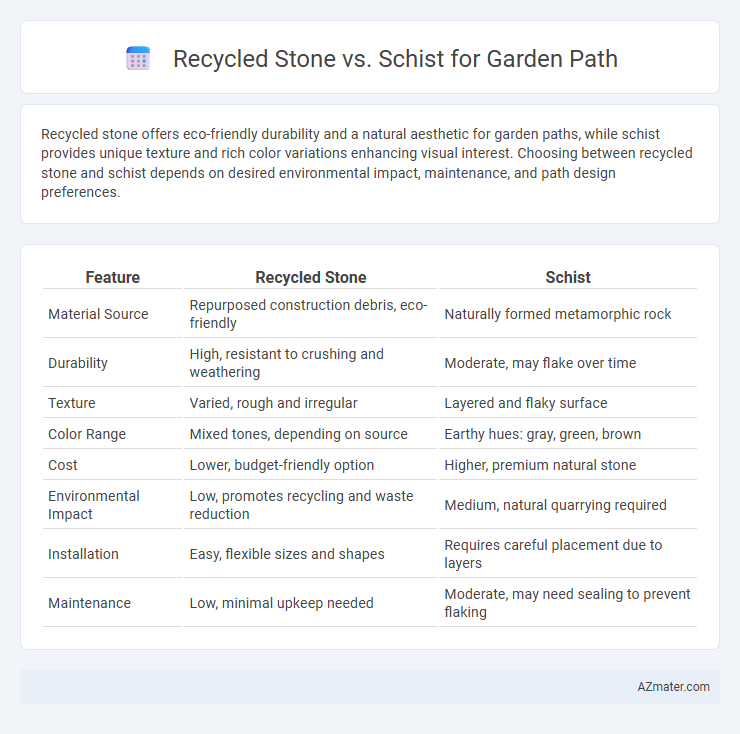Recycled stone offers eco-friendly durability and a natural aesthetic for garden paths, while schist provides unique texture and rich color variations enhancing visual interest. Choosing between recycled stone and schist depends on desired environmental impact, maintenance, and path design preferences.
Table of Comparison
| Feature | Recycled Stone | Schist |
|---|---|---|
| Material Source | Repurposed construction debris, eco-friendly | Naturally formed metamorphic rock |
| Durability | High, resistant to crushing and weathering | Moderate, may flake over time |
| Texture | Varied, rough and irregular | Layered and flaky surface |
| Color Range | Mixed tones, depending on source | Earthy hues: gray, green, brown |
| Cost | Lower, budget-friendly option | Higher, premium natural stone |
| Environmental Impact | Low, promotes recycling and waste reduction | Medium, natural quarrying required |
| Installation | Easy, flexible sizes and shapes | Requires careful placement due to layers |
| Maintenance | Low, minimal upkeep needed | Moderate, may need sealing to prevent flaking |
Introduction to Recycled Stone and Schist
Recycled stone, derived from repurposed construction debris, offers an eco-friendly and cost-effective option for garden paths, often featuring a mix of materials like concrete, brick, and natural stone fragments. Schist, a metamorphic rock characterized by its foliated texture and durability, provides a visually appealing, naturally slip-resistant surface ideal for outdoor landscaping. Choosing between recycled stone and schist depends on desired aesthetics, environmental impact, and budget considerations for garden pathway projects.
Eco-Friendly Benefits of Recycled Stone
Recycled stone offers significant eco-friendly benefits for garden paths by reducing waste and minimizing the demand for new quarrying, which helps preserve natural landscapes and biodiversity. Its reuse decreases the carbon footprint associated with manufacturing and transportation compared to Schist, a natural stone requiring energy-intensive extraction and processing. Incorporating recycled stone in garden design supports sustainable landscaping practices by promoting resource conservation and reducing environmental impact.
Natural Aesthetics of Schist
Schist offers a unique natural aesthetic for garden paths with its layered texture and earthy tones, creating an organic, rustic charm that complements diverse garden designs. Unlike recycled stone, which can have mixed colors and irregular shapes, schist provides consistent, visually appealing striations that enhance the path's natural look. Its durability combined with visually distinctive foliation makes schist a preferred choice for gardeners prioritizing both beauty and long-lasting materials.
Durability Comparison: Recycled Stone vs Schist
Recycled stone offers high durability due to its dense composition and resistance to cracking, making it ideal for heavy foot traffic in garden paths. Schist, a natural metamorphic rock, provides moderate durability but may be prone to flaking and erosion over time in moist environments. When comparing longevity, recycled stone typically outperforms schist in maintaining structural integrity under weather stress and frequent use.
Installation and Maintenance Requirements
Recycled stone offers ease of installation due to its uniform size and shape, allowing for quick placement and stable pathways, while schist requires careful arrangement because of its natural, uneven slabs to ensure safety and aesthetics. Maintenance for recycled stone involves simple periodic cleaning and occasional replenishment of base materials, whereas schist paths demand more frequent inspection for loose stones and moss control to prevent slippery surfaces. Both materials benefit from proper drainage installation, but schist's natural texture may require more labor-intensive upkeep to maintain its visual appeal and durability.
Cost Analysis of Both Materials
Recycled stone generally offers a more cost-effective solution for garden paths, with prices ranging from $1 to $3 per square foot, making it ideal for budget-conscious projects. Schist, a natural metamorphic rock, typically costs between $4 and $7 per square foot due to its durability and aesthetic appeal, resulting in a higher upfront investment. Considering installation, recycled stone often requires less labor and preparation, further reducing overall expenses compared to the more labor-intensive process associated with schist paths.
Slip Resistance and Safety Considerations
Recycled stone offers excellent slip resistance for garden paths due to its naturally rough texture, which provides good traction even when wet. Schist, a metamorphic rock with a flaky surface, can become slippery under moist conditions, posing safety concerns for walkways. Choosing recycled stone enhances safety by minimizing slip hazards, making it a preferable option for garden path surfacing where traction is critical.
Design Flexibility and Color Options
Recycled stone offers extensive design flexibility for garden paths due to its mix of textures and sizes, allowing for creative layouts that can complement various garden styles. Schist provides rich, natural color variations ranging from greens to browns and grays, enhancing aesthetic appeal with its distinctive layered look. Both materials accommodate diverse design preferences, but recycled stone is often favored for its sustainable qualities and adaptability in patterning.
Sustainability and Environmental Impact
Recycled stone offers a sustainable option for garden paths by repurposing existing materials, reducing quarrying and minimizing landfill waste, which significantly lowers environmental impact. Schist, a natural metamorphic rock, requires extraction from quarries, contributing to habitat disruption and higher carbon emissions associated with mining and transportation. Choosing recycled stone supports circular economy principles and conserves natural resources compared to the more environmentally intensive processing involved with schist.
Choosing the Best Material for Your Garden Path
Recycled stone offers eco-friendly durability with a rustic appearance, while schist provides natural layered textures and rich earth tones for aesthetic appeal. When choosing the best material for your garden path, consider factors such as drainage capabilities, slip resistance, and the overall style of your garden. Prioritize recycled stone for sustainability and cost-effectiveness, whereas schist excels in visual impact and long-term weather resistance.

Infographic: Recycled stone vs Schist for Garden Path
 azmater.com
azmater.com